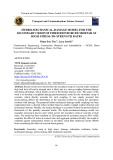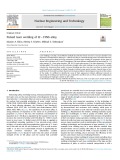
Micro-crack
-
The scope of this work is threefold: (i) to develop a new model within the framework of hydro-mechanical – damage coupling that can account for the coupling between microcrack (damage), water diffusion and shrinkage at stake for concrete secondary creep; (ii) to implement it in an existing hydro-damage lattice model; (iii) to validate the model with respect to the flexural creep of Fiber Reinforced Concrete (FRC) and Mortars under high sustained load level.
 12p
12p  vibecca
vibecca
 01-10-2024
01-10-2024
 2
2
 1
1
 Download
Download
-
The results show that ultimate strength under static loading can not be used as a quality criterion for zirconium alloys welds. Increased shielding gas flow rate does not allow to protect weld metal totally and contributes to defect formation without using special nozzles. Several types of imperfections of the welds have been found, but the major problem is branching microcracks on the surface of the welds.
 8p
8p  minhxaminhyeu3
minhxaminhyeu3
 12-06-2019
12-06-2019
 18
18
 0
0
 Download
Download












